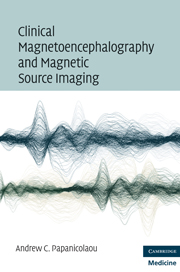Book contents
- Frontmatter
- Contents
- Contributors
- Preface
- Section 1 The method
- Section 2 Spontaneous brain activity
- Section 3 Evoked magnetic fields
- 19 Recording evoked magnetic fields (EMFs)
- 20 Somatosensory evoked fields (SEFs)
- 21 Movement-related magnetic fields (MRFs) – motor evoked fields (MEFs)
- 22 Auditory evoked magnetic fields (AEFs)
- 23 Visual evoked magnetic fields (VEFs)
- 24 Language-related brain magnetic fields (LRFs)
- 25 Alternative techniques for evoked magnetic field data – future directions
- Postscript: Future applications of clinical MEG
- References
- Index
20 - Somatosensory evoked fields (SEFs)
from Section 3 - Evoked magnetic fields
Published online by Cambridge University Press: 01 March 2010
- Frontmatter
- Contents
- Contributors
- Preface
- Section 1 The method
- Section 2 Spontaneous brain activity
- Section 3 Evoked magnetic fields
- 19 Recording evoked magnetic fields (EMFs)
- 20 Somatosensory evoked fields (SEFs)
- 21 Movement-related magnetic fields (MRFs) – motor evoked fields (MEFs)
- 22 Auditory evoked magnetic fields (AEFs)
- 23 Visual evoked magnetic fields (VEFs)
- 24 Language-related brain magnetic fields (LRFs)
- 25 Alternative techniques for evoked magnetic field data – future directions
- Postscript: Future applications of clinical MEG
- References
- Index
Summary
Overview of SEFs
SEFs have been used since the early 1990s to map functionally intact somatosensory cortex. Elicited by electrical stimulation of the peripheral nerves or mechanical stimulation of the skin of the upper and lower extremities, body trunk, or head, SEFs have various advantages over somatosensory evoked potentials (SEPs), which are evoked in a similar manner. In particular, the initial components of SEFs (early- and middle-latency peaks) cannot only identify the central sulcus, but also precisely demonstrate the somatotopic organization of the primary sensory cortex. In contrast to SEPs, SEFs are particularly useful for functional localization and evaluation of activation within sulci since, unlike EEG that measures both the tangential and radial currents, MEG is mostly sensitive to current sources tangential to the scalp. The sources of SEF components that are obtained through separate mechanical stimulation of each finger, toe, and the perioral area – usually the corner of the lower lip – and modeled as successive single ECDs originate from the contralateral primary sensory cortex within the central sulcus (mostly area 3b). The accuracy of SEF-based central sulcus location estimates has been repeatedly confirmed through comparisons with intraoperative corticography. In addition, functional abnormalities along the ascending somatosensory pathways can be quantitatively evaluated by the latency delay with or without concomitant amplitude attenuation.
The sensitivity of MEG/MSI for clinical evaluation of the brain mechanism responsible for somatosensory function is further attested by demonstrations of altered somatotopic maps or even complete displacement of the primary somatosensory areas.
- Type
- Chapter
- Information
- Clinical Magnetoencephalography and Magnetic Source Imaging , pp. 118 - 127Publisher: Cambridge University PressPrint publication year: 2009



